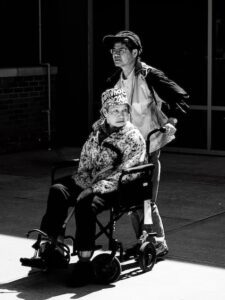Page Contents
Activities of Daily Living (ADL) is a set of basic self-care activities that are essential in determining the independence of a person. A person who is incapable to performing any of the pre-defined activities requires support care and rehabilitation to regain functionality and resume normal living condition.
Two categories of ADL
There are 2 main categories of ADLs. The first group is the basic self-care activities on physical tasks, namely Basic ADL, while the second group is instrumental ADL (IADL) which includes activities that require higher order, complex thinking to function within a society.
Basic Activities of Daily Living (Basic ADL)
Different countries and care systems define the basic activities differently. Nevertheless, it commonly consists of:
- Personal hygiene – grooming, bathing, showering, washing, brushing teeth.
- Toileting or continence – managing bowel and bladder movements, access to restroom, clean oneself properly after toiletings.
- Dressing (and undressing) – choosing clothes, putting them on, and managing personal appearance.
- Eating – feeding oneself, chewing and swallowing.
- Ambulating or functional mobility – getting around freely and safely.
- Transferring – ability to move from one body position to another.
Instrumental Activities of Daily Living (IADL)
Instrumental ADL is about the skillsets that are required for a person to interact and perform analysis in order to function within the community. Some examples are:
- Managing finances – managing financial assets and bills.
- Performing housework – home cleaning, laundry, and maintenance.
- Communicating – through telephone, mail, email, etc.
- Shopping – shopping for daily items and groceries.
- Preparing meals – cutting, cooking, and cleaning up.
- Managing transportation – wayfinding, driving, taxi hailing, and using public transports.
- Managing medications – obtaining medications and taking them according to prescription.
What could affect your ADL?
Some health events could affect your physical abilities either temporary or permanently and lead to impairment of ADL. For example:
- Children with developmental disabilities
- Elderly who are frail, sarcopenia and experiencing functional impairment
- Survivors of accidents (burn patients, disabled and amputees)
- Demented patients
- Other chronic health conditions (stroke, heart attack, diabetes, hypertension, etc.)

Implications of inability to perform ADL
When you are unable to carry out some of the activities of daily living, it could actually affect your life in various aspects.
- Post greater safety risks.
Often, when you have difficulty performing ADL, you will not be responding to threats as instinctive as a healthy or ambulant individual.
- Potential health risks.
If you are suffering long-term or permanent disability and not able to carry out basic ADL, your chances of developing other health implications would increase significantly. For example, obesity, hypertension, heart diseases, diabetes, stroke, etc.
- Reduce the quality of life.
When you are experiencing many limitations in daily life and require the assistance of a caregiver, inevitably, your quality of life will be affected tremendously.
- Reduce your opportunities and life experiences
Quality of life aside, inability to perform basic ADL could restrict your opportunities as compared to a healthy individual, for instance, pursuing education, taking transport, job opportunity, setting up a family, and so forth.
What if you have difficulty in performing ADL?
When you are unable to perform basic ADL for a period of time, likely, you may need to engage a certified caregiver.
In a household setting, hiring an on-request or live-in caregiver is helpful as most household tasks are taken care of.
If you need rehabilitation for faster recovery, staying in a nursing home, assisted living facility (ALF), community hospital, and so forth may be a better choice.


What are your chances of recovery?
With a proper curated rehabilitation program by physiotherapists and occupational therapists, the chances of recovery for a mild ADL patient is actually quite high. However, it is also depends on the age of individual patient, severity of functional impairment, individual’s determination and persistence for recovery, and also social and family supports.
Conclusion
To ensure you have less worry about impaired ADL, here are 4 things that you can start working on them today.
- Maintain a healthy diet and lifestyle.
Healthy diet, active lifestyle, sufficient rest, caring for mental wellness can minimise your risks of falling ill and ensure optimal functionality.
- Go for an annual health screening.
Annual health screening is helpful to pick up signs and symptoms of many hidden health conditions and allows you to take early interventions.
- Be conscientious in your daily activities.
Accident is one of the causes of impaired ADL. Fortunately, some accidents are avoidable. Be conscientious and mindful while you are driving, walking, and basically, all activities.
- Get appropriately insured.
The most important thing you need to prepare is to get appropriate insurance protection to cover for healthcare cost and continual income.
